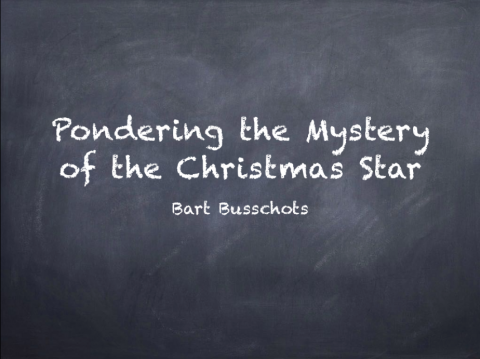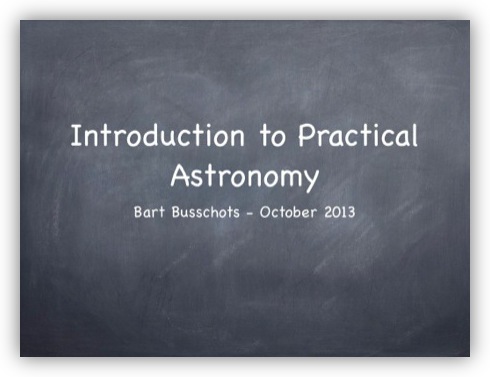Dec
1
The Christmas Star (Astro2 December 2015)
Filed Under Science & Astronomy on December 1, 2015 | 2 Comments
The slides for my talk to Astro2, the Astronomy & Physics society of Maynooth University.
The slides refer to demo scripts. These are scripts for the free and open-source planetarium software Stellarium. You can download the scripts here, and you can get instructions on how to install the scripts into Stellarium on their documentation wiki – specifically, you’ll need the section on file locations, and the section on installing scripts.
Oct
23
Presentation – Intro to Practical Astronomy
Filed Under Science & Astronomy on October 23, 2013 | Leave a Comment
Last night I gave a talk to Astro2, the Astronomy & Physics society in NUI Maynooth. This is a slightly updated version of a talk I’ve been developing over the past few years. It’s an hour long an aims to explain the jargon you’re likely to come across on Astronomy websites (or magazines if you still do the dead-tree thing), to quickly summarise the kinds of things you can see in the sky, and to look at the kinds of equipment you might want (no, you really don’t need a telescope).
Dec
17
The Christmas Star & Apollo
Filed Under Science & Astronomy on December 17, 2008 | 2 Comments
It’s become sort of a tradition that each year I give the Christmas lecture for Astro2 (The Astronomy & Physics Society of NUI Maynooth). Each year I give a talk on the Christmas Star and each year I change it up a bit and focus more on different aspects. I really changed the talk up quite a bit this year and got quite a bit deeper in the biblical end of things than I had before. I enjoyed giving the talk this evening, and the audience seemed to enjoy it too which is always nice!
Mar
29
Partial Eclipse Observed from Maynooth
Filed Under 42 (Life the Universe & Everything) on March 29, 2006 | Leave a Comment
Astro2 held an observing session along with the Physics department for today’s partial solar eclipse. They had a nice array of Telescopes there, two set up to project an image onto screens and then a PST for observing the Sun directly in H-alpha. I was technically at work so I couldn’t stay for the whole eclipse but coffee time coincided nicely with maximum eclipse so I got to see about 20 minutes starting just after maximum. The view in the PST was spectacular, some lovely prominences and also two small sunspots near the eclipsed bit of the moon.
Myself and another colleague watched a live webcast from Turkey from work for a few minutes either side of totality. It was no where near as impressive as actually being there but it was still nice to do something for the eclipse.
Mar
1
A Small But Dedicated Crew of Observers
Filed Under 42 (Life the Universe & Everything) on March 1, 2006 | Leave a Comment
Yesterday was a bitterly cold day and last night was no warmer. After the excellent Astro2 talk on Science, Religion and Dawkins only three of us were brave enough to venture out into the cold for some observing but for those of us that did it was well worth it. We had stunning views of Saturn showing the cloud bands and the Cassini division very clearly, amazing views of the Orion Nebula at ridiculously low magnification (30X) so as to get th entire thing into the same field of view and then we zoomed in on the core for a closer look. We also took in some of the open clusters in Auriga and M35 in Gemini as well as a rather un-impressive M1 (light pollution really spoils it). We then finished off with another look at Saturn because none of us could get enough of that beauty!
Feb
8
An Unexpected Observing Session
Filed Under 42 (Life the Universe & Everything) on February 8, 2006 | Leave a Comment
We had an unexpected observing session at the Astro2 meeting today. As we went in to the excellent talk on Gravitational waves it was pelting with rain but when we came out later the sky had completely cleared and there wasn’t a cloud in sight so we all trudged up to the physics department observatory for a wonderful observing session.
We started out with a look at Saturn, first at 100X and then at 190X. The air was not very stable so close after a major weather system had passed by so although Saturn looked very crisp (and big) at 100X even 190X was starting to push the limits a bit. At 190X we could clearly see the cloud bands on Saturn, the shadow of the rings and in moments of good seeing the Cassini Division in the rings. Saturn looked a little nicer than usual today because the background was just peppered with loads of stars from the large open cluster M44 (the Beehive Cluster) which Saturn is currently moving through.
After Saturn we turned our attention to The Orion Nebula (M42). Because the over half full moon was very close to Orion I decided to go for as low a magnification as possible to give maximum stability, contrast and sharpness to our view. Even with the moon interfering the nebula still looked stunning at 62X with the LX200. The contrast was excellent and all four stars of the trapezium were easily separable. There was also a lot of detail visible in the nebula. All in all people seemed impressed with the view since there were lots of oooh’s and aaaah’s as people were looking.
Finally, after everyone had had a good look at M42 we moved on to the moon. We started at 62X so that people could see the whole disk at once and also get an idea of the scale of the Orion Nebula which they had just seen at the same magnification. We ended the session by allowing everyone a ‘moon walk’, i.e. I put in our highest eyepiece (6.4mm giving a magnification of 390X) and gave each person observing the key pad and let them scan the moon for a while.
All in all it turned out to be a great observing session probably made all the more enjoyable by the fact that none of us had expected the opportunity for observation to present it self tonight!
Sep
28
First Astro2 Observing Session of the year
Filed Under 42 (Life the Universe & Everything) on September 28, 2005 | Leave a Comment
Well, Astro2 had it’s first observing session of the year and despite the weather being far from ideal we did actually manage to see some stuff and we also had a good turnout of about 20 people who braved the cold on the physics roof!
When we first went onto the roof observing conditions were far far from ideal, about 30% – 40% cloud cover and the areas that were ‘clear’ were still quite hazy. Thankfully the longer we stayed up there the clearer it got.
We only had use of our own ETX90 and our binoculars because the college’s LX200 was out of order. This made things a little more difficult because it meant we had no automatic tracking and no finder scope (don’t ask) so I stuck to a 32mm eye piece to keep the magnification low and only went for objects that were big, bright and easy to find.
We got a good look at the globular cluster M13, the Andromeda Galaxy (M31) and the double cluster in Perseus. I was hoping to track down the Dumbbell Nebula (M27) and the Ring Nebula (M57) but without a finder scope tracking down something in the midst of the Milkyway is just not gonna work so when my fingers got numb I gave up!
We also spotted some satellites and an Iridium Flare and we did some introductory stuff with our new members pointing out some of the constellations. Although it was far from an ideal night I still think a good time was had by those who showed up.
One thing that did infuriate me a bit was that Mars didn’t come up high enough to be seen from the roof till I was on my way home and spotted it in all it’s red glory taunting me from low in the sky next to the Hume building!








